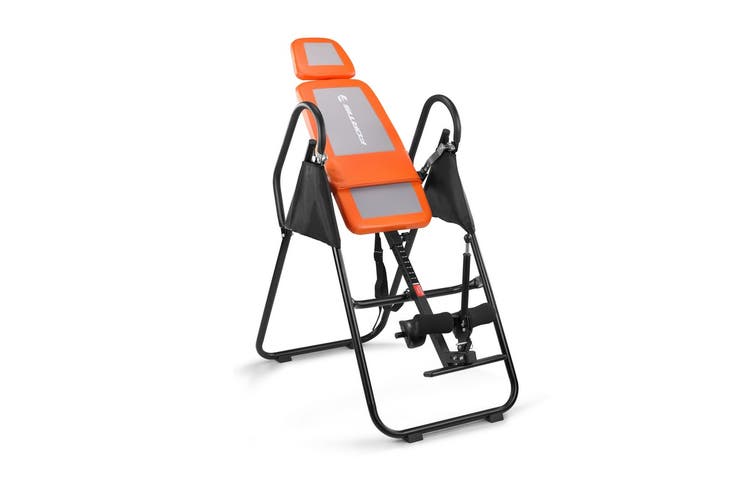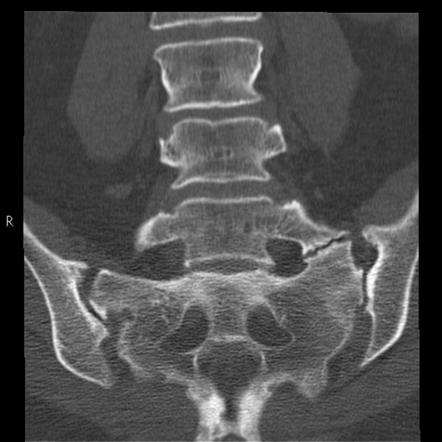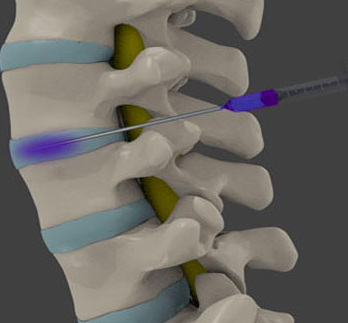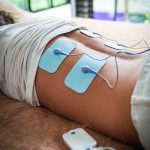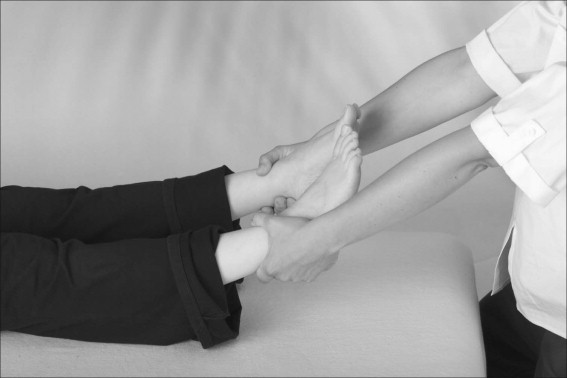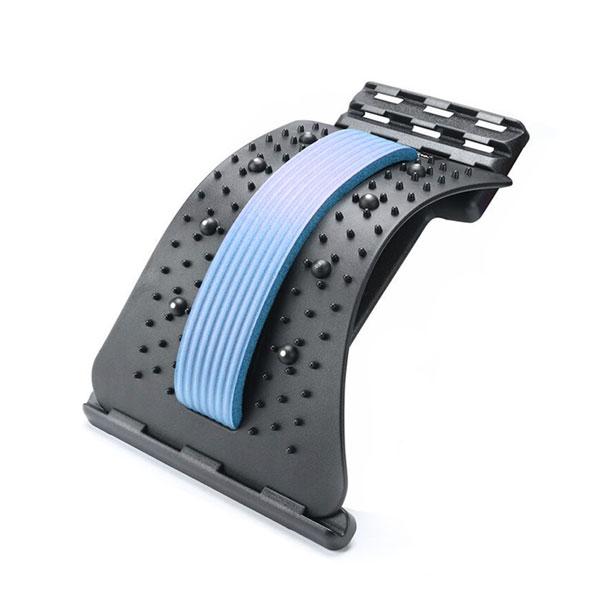Article reviewed and approved by Dr. Ibtissama Boukas, physician specializing in family medicine
The inversion table is sometimes used to relieve back pain and herniated disc, in particular by reducing the stress on vertebrae lumbar.
Is it an interesting solution against lower back pain? What are the benefits, side effects and risks? What does scientific research say?
This article will cover everything you need to know about the inversion table, and I'll conclude by giving my physio opinion on this treatment option for back pain.
What is Inversion Therapy?
Do you sometimes want your spine to be stretched to relieve your back pain? This is exactly what the concept of inversion therapy refers to!
The inversion table is a technique that consists of hanging yourself upside down to stretch the spine and relieve back pain. The theory goes that by reducing the force of gravity on your vertebrae, we experience less stress on your spine, allowing symptoms to be reduced.
For these reasons, inversion therapy may be beneficial for people suffering from:
- Chronic pain dorsal or lumbar
- disc protrusion et herniated disc
- Sciatica
- Cruralgia
- Degenerative disc disease
- Lumbar osteoarthritis
Read on to learn about the benefits, risks, and ways to use the inversion table.
What do the scientific studies say about the inversion table?
Some doctors and health professionals attest that the inversion table can solve and prevent back problems. They also claim that the stretching of the spine and the activation of blood circulation associated with this technique can help prevent certain health problems.
Specifically, here are the theoretical benefits conveyed by proponents of the inversion table:
- It increases the amount of protective synovial fluid intervertebral discs
- It creates a decompression of the discs by separating the vertebrae between them: Inversion therapy can improve the space between the discs of the spine and relieve the pressure. Activities such as sitting, running, and bending can put pressure on these discs. This pressure increases the risk of back pain, compression of the vertebrae and other complications.
- It removes harmful toxins from the spine
- She decreases inflammation
- It increases blood circulation in the surrounding muscles.
- It improves flexibility and posture
Here is the result of some studies in favor of inversion therapy:
Reduced back pain
A study was carried out with 47 people suffering from chronic low back pain. They used an inversion table for 3 sets of 3 minutes at different angles. The study found that the 60-degree incline inversion table was the most effective in reducing pain after eight weeks. Participants also noted an improvement in core flexibility and strength.
Reduced need for surgery
A 2014 study suggests that the traction table's anti-gravity action can potentially prevent disability from back problems. It could also reduce the need for surgery of the spine.
Another 2012 study found that people with low back disease delayed surgery by 6 weeks due to symptom reduction with inversion therapy.
Types of inversion tables and alternatives
The inversion table isn't the only option for creating anti-gravity action. Here are several accessories for applying inversion therapy:
Conventional inversion tables
Most tables are designed to help you stretch your back for a few minutes while standing on it with your head down.
But depending on the brand and model, you can also do exercises in an inversion table. Some people choose the model that allows them to do rotations of the torso and abdominals.
The price of inversion tables varies depending on the number of functions, with some costing as little as $80, others over $500. There are also harnesses that can be attached to a door to perform spinal decompression.
Inversion chairs
Inversion chairs are based on the same principle as the inversion table. The main difference is that the person is sitting instead of standing.
They are more expensive than inversion tables, and cost between 100 and 400 euros depending on the brand and model.
Gravity (Inversion) Boots
These heavy-duty boots support the ankles, and are designed to be attached to a bar and allow for upside-down suspension. Let's just say that this tool is not for everyone...
Alternative methods
Traction table
This is a technique used by many physiotherapist (physiotherapist) and chiropractor with people who suffer from back pain.
Instead of being upside down, the traction table allows you to adopt a lying position on your back. A device fitted with a strap and a cord allows spinal decompression, thus spacing the vertebrae from each other.
The indications are similar, and the risks are generally lower compared to the inversion table. On the other hand, it is necessary to consult a health professional to benefit from this technique without risk.
Yoga
You may be able to experience the benefits of inversion therapy through certain yoga poses (asanas). These include in particular:
- The “hand stand”
- Headstand
- The posture of the plow.
These poses ideally require the guidance of a medical professional, or a certified yoga teacher.
Le aerial yoga is another option. Billed as "gravity-defying," aerial yoga uses circus props and involves several upside-down poses.
Once again, it is essential to be accompanied by a professional, and to check with a doctor if this practice is right for you.
Spinal decompression table
These instruments can be used at home. Unlike the inversion table, they keep the head relatively stable while providing an effect of lumbar traction.
These traction tables can be found here.
Risks of inversion therapy
The inversion table is considered dangerous for people suffering from certain pathologies. Indeed, the head down position increases blood pressure and decreases heart rate. It also exerts significant pressure on the eyeballs.
Your doctor may not recommend the inversion table if you have certain conditions, including:
- Bone and joint disorders, such as osteoporosis, herniated disc, vertebral fracture or other spinal injury
- Cardiovascular disorders, such as high blood pressure, stroke, or heart disease
- Diseases or infections such as conjunctivitis, any ear infection, or glaucoma.
Other factors can lead to complications, including
- Retinal detachment
- The pregnancy
- obesity
- The use of drugs for blood clotting
It also takes time to adapt to the inversion table. It is best to start with very short periods, and gradually increasing the angle of inversion.
Gradual use may help reduce side effects such as dizziness or muscle spasms. If in doubt, slow down and seek advice from a healthcare professional.
Inversion table: Opinion of the physiotherapist
As a healthcare professional, you should use a scientific approach to recommend any form of therapy to your patients.
Unfortunately, most studies on the inversion table are of poor quality, making their conclusions unreliable. As for the quality studies, they generally conclude with a lack of effectiveness of the traction tables.
However, the positive feedback from many patients who have tried it, and who have seen an improvement in their symptoms, should not be underestimated. Thus, in certain special cases, it may be interesting to try the traction table.
The important thing to remember is that this treatment approach is a tool to reduce pain, and will not correct the source of the problem (contrary to what is conveyed by inversion table dispensers).
This comes from the fact that low back pain is multi-factorial, and cannot be reduced to an increase in stress on the vertebrae only. Other factors must be taken into consideration, such as the stress, sleep, the level ofphysical activity, muscle and joint imbalances, supply, etc.
In short, I prefer to use less drastic modalities with my patients suffering from back pain. But sometimes I use inversion therapy when other treatment techniques do not offer favorable results.
Also, I make sure that the patient does not present any risk, and starts with a safe angle which will be progressed little by little to avoid any accident. In general, fit and athletic patients tolerate this therapy best.
Obviously, the inversion table is integrated within a global approach integrating rehabilitation exercises, therapeutic education, as well as an effort to modify lifestyle (stress and sleep management, postural corrections, etc.).
For those who cannot tolerate the upside-down head position, I prefer to opt for a spinal decompression table which offers a similar result.
User manual
Here's how to use an inversion table:
- Install it in an open area:
Install the table in a spacious place to be sure that nothing gets in your way when the table tilts. You can place an anti-slip mat for more safety and stability. Avoid rugs that tend to slip.
- Adjust its height:
The inversion tables adapt to the size of each one. So take the time to properly adjust it to your size by positioning yourself in front to get an idea of the size needed. This model allows you to adjust the height thanks to a system of notches. You can readjust the height later if it does not suit you.
- Adjust the tilt angle:
Then install the tilt limitation bar (highest notch at the beginning). You can try the lower notches as you go, then remove the bar to enjoy a full inversion.
- Get comfortable :
Once the height and angle are set, attach your feet and ankles to the device. You can keep your shoes on for added protection. Place your neck between the 2 headrests. You can fasten the seat belt if you want to be even better supported. You can then inflate the lumbar cushion if you wish it.
- Tilt the table:
Using the handles on each side, tilt the table. Start gently tilting the table until you touch the limit bar (previous setting). As there are no nerve endings in the discs, we do not necessarily feel the intensity of the decompression. Go slowly during your first session and start to incline more when you are comfortable with the device (it is not mandatory to incline up to 180°, the benefits will be similar and it will be safer for the most vulnerable).
- Adjust the inclination, duration and frequency of sessions:
There is no right or wrong duration. You just have to listen to your body and not stay upside down for too long. The majority of people use it in 10 minute sessions, 3 times a week.
According to the study cited above, shorter but daily sessions seem to produce the most benefits 3-4 minutes 2-3 times a day. If your pain disappears less frequently, you can decrease the frequency and simply use it once in a while to prevent pain.
If using an inversion table causes an increase in symptoms, please discontinue the activity and seek advice from a healthcare professional.
Also, when using your inversion table, your muscles and ligaments which are normally in tension to relax by “suspending” your spine in place. When you return to a standing position, it takes a few minutes for fibers return to normal. Consequently, your back is a little more fragile immediately after the session. This is why it is not recommended to do intense activities immediately after a session.
Conclusion (in the form of summarized points)
- Inversion therapy consists of gradually placing yourself upside down to exert disc decompression and stretch the spine.
- It may provide short-term benefits, such as relief from lower back pain and increased flexibility.
- This practice comes with risks, and cannot be performed on people with certain health conditions.
- From a scientific point of view, the studies making it possible to conclude that the inversion table is effective are very limited.
- The cost of an inversion table varies from 70 to 400 euros, depending on the brand and model.
- As a physiotherapist, I believe that the inversion table can only be used in certain cases, and should never replace methods already proven by science (exercise, stress and sleep management, etc.).
- An interesting alternative would be spinal decompression tables.

